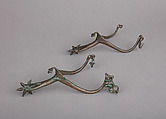Pair of Rowel Spurs
Not on view
Around 1400, the length of the rowel spurs’ necks started to increase in western Europe, some examples extending even as long as the rider’s foot in the 15th century. At this period, the elevated war saddles and the very specific riding style, with long stirrup leathers and legs extended forward, had the consequence of taking away the rider’s feet from the horse’s flank. Thus, these long necks gave them easier access without having to disturb the rider’s position. As well as being necessary equestrian instruments, spurs were one of the symbols of knightly status, and were among the objects given to the knight during his knighting.
This image cannot be enlarged, viewed at full screen, or downloaded.
This artwork is meant to be viewed from right to left. Scroll left to view more.



